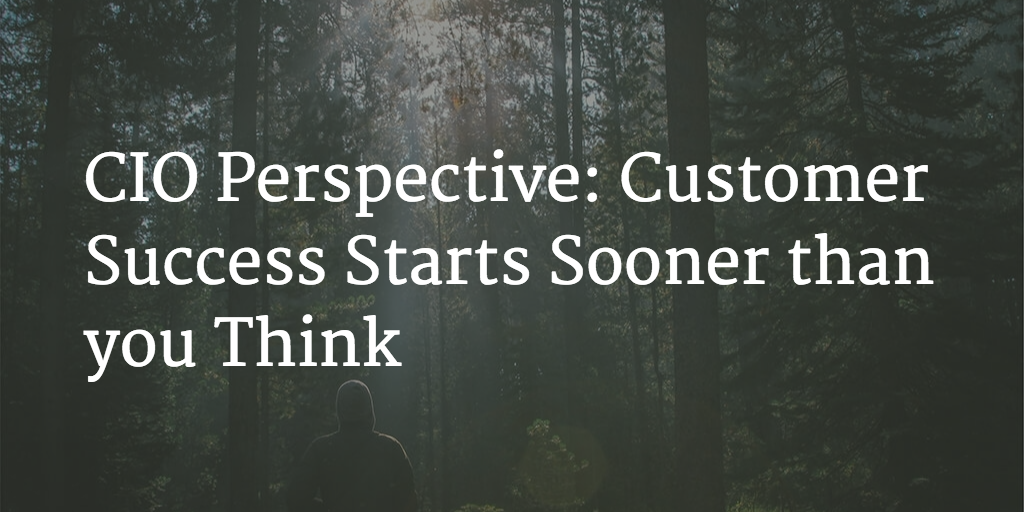The CIO. Steve Jobs was adamant about not wanting to take Apple into the enterprise business because it would mean, “we would have to deal with 500 orifices called CIO’s.”
I’d like to think things have moved on – Apple has now made a huge move into the corporate sector and partnered with – of all companies – IBM to focus on working with their largest enterprise customers.
And the CIO has become a more critical part of companies that want to scale, move from being a fixer to enabler and most critically as a buyer of cloud apps be responsible for internal Customer Success.
Early on in my career I was in a technology sales role providing clients with IT consultancy services and custom web development. We focused on building business process automation and collaboration systems (yes I am that old). Having been on the sell side – but more recently on the buy side – I am often asked about how to sell to the CIO and what most CIO’s tend to focus on when buying a solution.
Whilst I hate to generalize, one of the biggest factors for making the decision to go with an Enterprise SaaS solution has been on what understanding what I refer to as “pathway to success.” As a CIO I want to critically know how your solution will be implemented, adopted, and then extensively used to exceed the value proposition.
In this post I want to provide the CIO perspective of customer success. And for the CIO this starts at the point of sale. When a vendor walks in to room to make that pitch – Customer Success needs to be demonstrated even before the contract is signed.
Let me explain.
Internal Customer Success: Start As You Shall Go On
In the SaaS world, customer success starts not at implementation but at point of sale. First impressions count – it’s not about impressing with a great product but the because the CIO is judging how implementation will go during this process. It is during this critical process that a number of interactions with the client happen.
The goals for each party however are different – one wants to make the sale and the other to deliver internal value. The sales process starts to build an expectation of what the end result will be but will be implicitly not aligned. Consider the mindset of the CIO in this situation – if he or she as a prospect has to do the follow up to find out for say get a status of where the contract review is at, than perhaps they have to do the same when there is a milestone approaching during an implementation.
The CIO needs to know that the company they are going to be working with is focused on customer success. More importantly in such a competitive environment the CIO needs to know that Customer Success is intrinsic within that company’s culture. From the sales process to contract signing and then to implementation to support.
Understand the Customer
A lot of sales pitches fail in the first few minutes because of lack of proper preparation but also because of failing to give relevance of the product. The CIO ‘s mindset when looking at a SaaS product is focusing on a solution for their company but also the industry they are in.
Relevance is critical when pitching to CIO’s because it gives both comfort and confidence that the solution is already partly designed for them – therefore the likelihood for customer success is high as the implementation will be relevant. I have seen and heard of far too many instances where a solution is being pitched in far too standard a fashion – the exact same pitch deck or demo being used with little or no relevance to that customers business or industry.
When a pitch has content pertaining to that CIO’s sector and more importantly references at peer group they can reach out to it is likely to be a stronger likelihood of success. Having a high NPS is not good enough – having a relevant one is.
Build Consensus for the End Decision
Whilst the CIO holds accountability for technology decisions he or she is surrounded by a capable team of people who hold considerable influence in that end decision. Most SaaS vendors make the mistake of thinking if they get a favorable response than a deal is forthcoming. Not true.
When you are having a meeting with members of the CIO’s team as part of your sales pitch know that the people present are not only enablers but also influencers in the buying decision. A huge misstep with SaaS vendors is the lack of understanding for what the dynamics are of the IT department. If you don’t know ask. An org chart is not the answer.
Who isn’t in the room that will be involved? CIO’s typically look to members of their team to decide on going forward so the more you are able to build consensus the more likelihood you are going to have success when implementing as well.
Now What?
One of my favorite closing movie lines comes from “The Candidate,” starring Robert Redford (ok I am old and old fashioned!). A reluctant politician wanting to just get his message out ends up winning the election. As his supporters rally around him to rejoice the candidate looks to his campaign manager and asks, “now what do we do?” You’ve closed the deal. You demonstrated to the CIO that your solution has relevance.
You and your colleagues have acted efficiently and professionally start to finish – from timely quote, supporting collateral, references, proposed plan, contract negotiation and contract signing. By engaging influencers in the client organization you have built consensus. WIN.
In our next post we will talk about some of the key implementation techniques and behaviors which CIO’s look for to ensure customer success.
